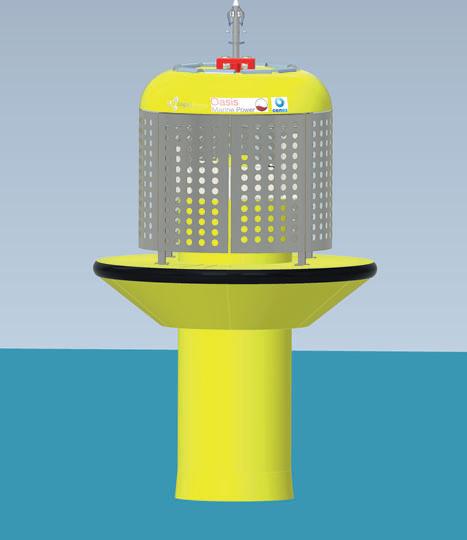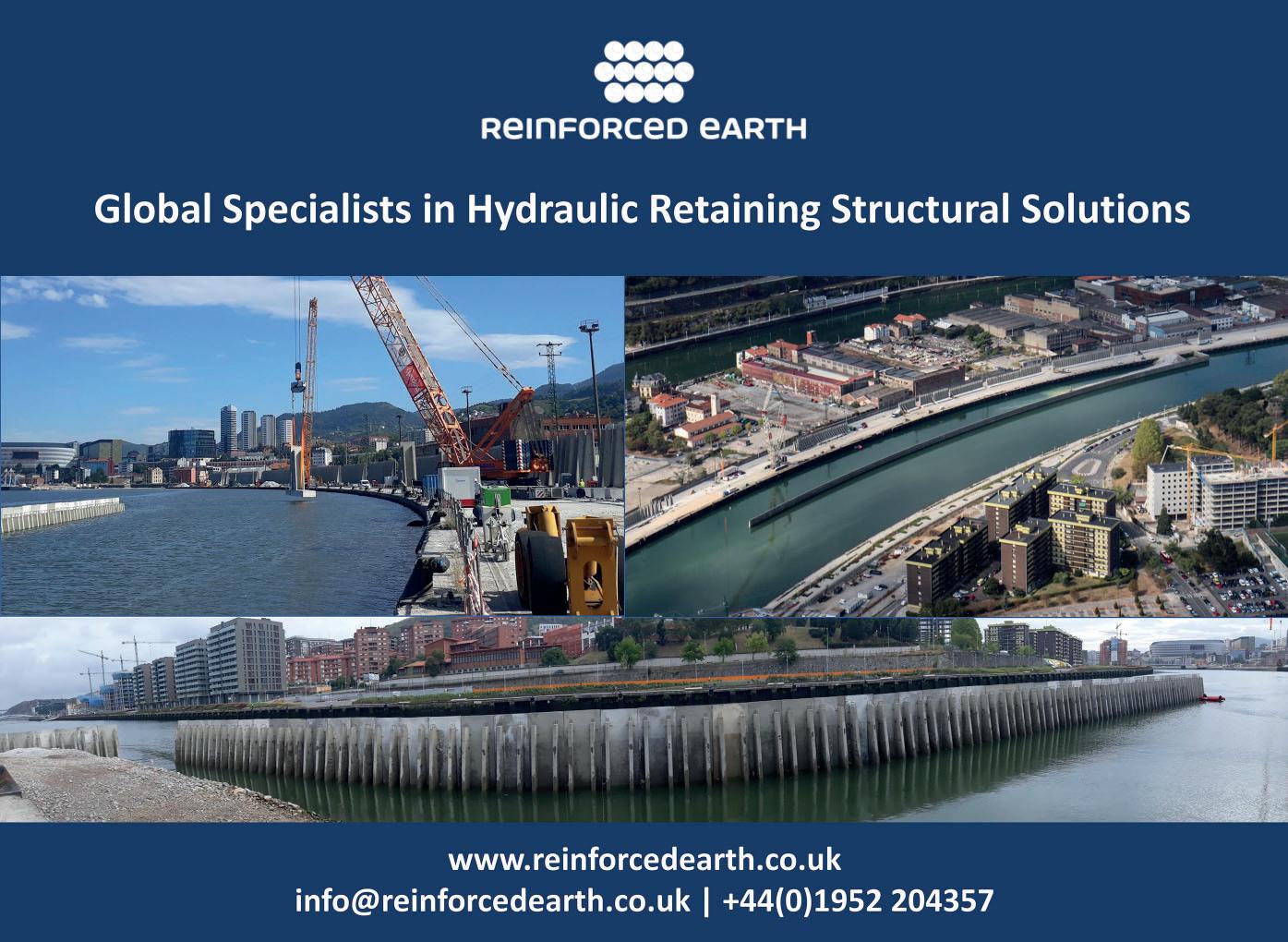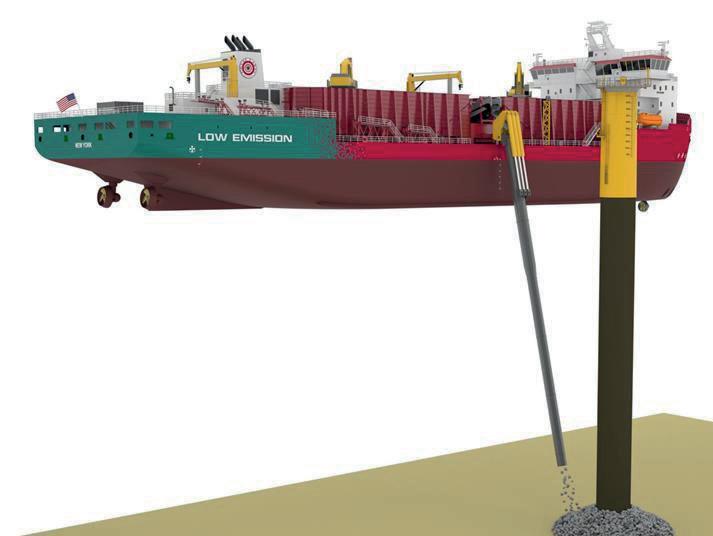
8 minute read
OSIL buoys for Baltic
OSIL SUPPLIES BUOYS TO BALTIC PROJECT
OSIL has supplied its advanced monitoring buoys to the Baltic Pipeline Project
8 Tunnel boring
machine

Global marine systems manufacturer Ocean Scientifi c International Ltd (OSIL) has provided some of its lightweight repositional environmental monitoring buoys to be used in the Baltic Pipe Project.
Seventeen 0.6m buoys will be in continual use to monitor the turbidity levels and other environmental conditions around the active dredging sites. ”Dredging activities are vital to the successful outcome of the project,” says OSIL. ”The buoys are very lightweight and easy to deploy, and on this project have been repositioned to follow the dredger movements and debris plume on an almost daily basis.
“The relocations were undertaken by minimal crew on board the dredger support tug, using a grapnel to catch the buoys and the vessel’s handling system to lift the anchor weight and tow the buoy to its new position. DHI A/S reported that the crew were very happy with this arrangement.”
The buoys have been delivered to DHI A/S, the software development and engineering consultancy firm headquartered in Denmark that is overseeing the project.
The 275km gas pipeline sending natural gas from the North Sea to Poland is due to be completed this October, when at full capacity it will transfer 10 billion m3 a year through on and offshore pipes from Norway to Denmark and Poland, and 3 billion m3 a year from Poland to Denmark.
It is being developed by Danish gas and electricity operator Energinet in combination with the Polish gas transmitter GazSystem, and has been recognised as ‘a project of common interest of the European Union’.
The goal is to create a new gas supply corridor in the European market that will transport gas from Norway to the Danish and Polish markets as well as to end-users in neighbouring countries.
Offshore, the pipe installed on the seabed crosses the marine areas of Denmark, Poland and Sweden in the North Sea.
It consists of about 22,000 sections of pipe, each 12.2 metres long, welded together and now buried in or laid on top of the seabed.
Italian firm Saipem was awarded the contract to transport and install the pipeline in the Baltic Sea.
On-land works
To lay the pipe on land, microtunnelling has been carried out – where the pipe is laid in concrete after tunnels are drilled beneath the seabed, beach and dunes.
“Thanks to this method, the seashore and dunes have not been affected, and the project execution has not caused major restrictions to the use of the beach,” the project leaders say.
As well as microtunnelling, three other methods of landfall construction were considered: open excavation, horizontal drilling and direct jacking.
The pipe has been laid about 1.2 metres deep, and above has been restored, with just four visible elements of infrastructure on land: one in Demark, three in Poland. ”After its commissioning in 2022, fine particle emissions from buildings may be reduced by even 54% which, in turn, could save as many as 25 000 human lives a year, while the reduction of carbon dioxide emissions by 70 million tonnes may contribute to 58% achievement of Poland’s 2030 target to reduce the emissions by 120 million tons,” the project leaders claim.
8 OSIL’s buoys are
monitoring the dredging carried out in the Baltic Pipeline project
The new Oasis Hydrogen Buoy concept could be come an off shore refuelling reality.
A UK consortium of industry stakeholders says it has come up with offshore infrastructure that would enable the hydrogen refuelling of small and medium-sized vessels in combination with other fuels. Jebb Smith Ltd, Logan Energy and Cenex are developing a Hydrogen Offshore Transport System (HOTS) using funding from the Department of Transport.
The consortium conducted a detailed review into the technical and economic feasibility of transferring hydrogen offshore, which led to the conceptual design adapted from existing onshore hydrogen refuelling technology. ”This initial HOTS design uses gaseous hydrogen and is appropriate for refuelling small to medium sized vessels, but most likely in combination with other fuels,” the consortium said. ”The conceptual design could commercially become the Oasis Hydrogen Buoy, an adaption of an offshore electric charging buoy currently in development by Jebb Smith.”
Infrastructure
One of the main hurdles to a greater roll-out of green hydrogen as a fuel is the lack of infrastructure up to the job.
“Considerable infrastructure developments will be required to facilitate hydrogen as a possible green future fuel, and our findings demonstrate that a solution is achievable and can further the development of hydrogen as a component for renewable energy opportunities,” said Jebb Smith managing director George Smith.
“A recent study shows that maritime transport emits around 940 million tonnes of CO2 annually,” said Bill Ireland, Logan Energy CEO. ”Refuelling vessels using clean hydrogen energy generated by offshore wind has tremendous solutions to help meet our net zero goals. We cannot be too ambitious in this regard.”
Nick McCarthy, Technical Specialist at Cenex, said: “As we aim to transition to a net zero economy, hydrogen is emerging as a key fuel of the future. This key piece of maritime infrastructure will support the development of hydrogen powered vessels, the creation of green hydrogen offshore, and the transporting of hydrogen in the maritime environment.
“We expect the HOTS system to be an integral part of zero emission shipping in the future and look forward to the next steps in its development.”
CONSORTIUM PLANS OFFSHORE H REFUELLING

8 Oasis Hydrogen Buoy

Marine engineers create islands at Maldives
Fears of rising sea levels have prompted the idyllic island nation to take drastic safe-guarding measures.
A plan to create 194 hectares of land at the Maldives will be carried out by marine civil engineering firm Van Oord, who will also install 11 kilometres of coastal protection as part of the contract. The land reclamation is part of the Addu Development Project, which aims to transform the city of Addu into a ‘fully functional, thriving economic hub and an attractive tourist destination’. Addu is the islands’ southernmost atoll.
Van Oord will reclaim land for the government’s Ministry of National Planning, Housing and Infrastructure along the coasts of the islands Hithadhoo and Maradhoo/ Maradhoo-Feydhoo, as well as create three islands in the city’s lagoon.
Using its HAM318 trailing suction hopper dredger (pictured), Van Oord will source sand from two areas in the lagoon, starting immediately. More than 80% of the islands of the Maldives are less than a metre above sea level, which means it has the lowest terrain of any country in the world, according to NASA.
The land reclamation is being done as part of a target to decentralise the islands away from the capital of Malé, which is why in 1997 building began to increase the island of Hulhumalé, to the north east of Malé.
It was expanded in size by four square kilometres by using sand pumped from the seafloor onto a submerged coral platform.
Now the fourth largest island in the archipelago, Hulhumalé is already home to 50,000 people, with 200,000 more expected to move there if sea level rises make Malé uninhabitable.

HUISMAN WINS US INSTALLATION CONTRACT
Huisman has been awarded a contract from USA-based Great Lakes Dredge & Dock Company LLC (GLDD).
The order is to equip GLDD’s newbuild rock installation vessel, which will support the development of offshore renewable energy production in US waters.
“We are pleased to work with Huisman regarding this critical element of our planned subsea rock installation vessel, which will provide a unique, technologically and environmentally advanced vessel for use in the US offshore wind industry,” said Eleni Beyko, senior vice president of offshore wind at GLDD.
Renewable transition
Huisman said it is committed to driving the growth of renewable energy and making mineral and fossil fuel extraction more sustainable. It has been developing its products to reflect this vision.
For example, this equipment has been optimised for installing scour protection necessary for offshore wind applications. This includes, for example, filter and armour layers for foundations, which it can install pre- or post foundation installation. It can also install the cable protection for both inter array and export cables.
The delivery of this new equipment will support GLDD’s ability to play a significant role in the development of the USA’s offshore wind industry.
For the project, Huisman will cooperate with TME, designer and producer of bespoke equipment for
8 Huisman is cooperating with GLDD and TME to deliver
this state-of-the-art rock installation equipment
the offshore, bulk, asphalt and concrete industries, utilising its robust and proven rock transport technology in the form of a plate feeder, shakers and hoppers.
David Roodenburg, CEO at Huisman, said: “We are proud to be part of this project that will support the growth of sustainable energy production in the USA. We look forward to cooperating with GLDD and TME to deliver this state-of-theart rock installation equipment, using our extensive experience in designing and building custom made large rock installation systems.”
Delivery of the rock installation equipment is scheduled for the first half of 2024.










